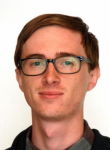Agdanowski, Matthew

Matthew is a student in the Biochemistry, Molecular and Structural Biology Graduate Program. He received his B.S. in Biochemistry and Cell Biology from the University of California, San Diego and is now working on his Ph.D under the guidance of Professor Todd Yeates. He entered the CMB training program in 2018.
Mentor: Dr. Todd Yeates
In the past few years there has been an explosion in the discovery of RNA molecules with interesting properties and functions once thought to be reserved to the realm of proteins. Historically, structural studies involving RNA have proven challenging, mainly due to the difficulty RNA has in forming stable crystal contacts; coupled with significant flexibility from weak tertiary interactions, this results in loosely packed, poorly ordered crystals which diffract to low resolution making structure determination strenuous if not impossible.
Recent advances in electron microscopy may be able to provide a unique solution to this ever-pressing problem. Over the last few decades technological advances in single particle cryo-EM, such as improved algorithms used for motion correction and data refinement, as well as the emergence of the direct electron detector, has allowed researchers to study large macromolecular complexes at atomic resolution. This growing technique, however, is unable to achieve the same quality of results when applied to single molecules. When the target to be imaged is below roughly 50kDa, the target’s signal becomes too low compared to the signal from noise to extract any meaningful data and solve the structure.
My work is to use a strategy developed in our lab to circumvent these challenging problems. Using a designed symmetrical protein scaffold, small RNA molecules can be docked onto our “cage” and their structures determined via cryo-EM. I believe that the knowledge gained from this endeavor will provide unique insights into the biochemical function of these novel RNA’s, perhaps leading to important breakthroughs effecting a range of biological fields.


